What was known about the sky in Central Europe during the Bronze Age? What kind of calendars were used? The worldviews of the Bronze Age societies and level of knowledge are still a mystery since they had no written language. The initial, not always uncontested, hints are only offered by discoveries like the Nebra Sky Disk, the Gold Hats, or the Trundholm Sun Chariot. But the issue is that there are several possible interpretations of what is shown on these objects and how they work. Thus, archaeoastronomers often have to fumble in the dark while studying this field, but it does not make them any less fascinating.
Travel to the European Bronze Age
4,000 years ago, Central Europe was far from being at the center of the world. Because the greatest cultural advances at that time occurred elsewhere: on the Mediterranean, in Mesopotamia, Egypt, and far-off India, sophisticated civilizations thrived, people there constructed large cities, communicated through writing, and created intricate social and administrative institutions. These civilizations’ accomplishments are attested to by the countless written records they have left behind.
Graves and depot findings, which are ancient artifacts that were buried in the ground, are the main sources of knowledge about Bronze Age life.
The difficulty of lack of writing
Contrarily, there was a substantial disparity in this regard in Central and Northern Europe. This is due to the lack of writing among the Bronze Age civilizations of this area. There is thus little knowledge available today on how the Aunjetitz, Tumulus, and Urnfield cultures’ inhabitants behaved, what they thought, and what they understood about their surroundings and the sky. Even the Celtic people of ancient Rome valued oral traditions above written documents.
Therefore, we must examine these artifacts if we wish to understand the worldview of our ancestors at that time—findings from archaeology that, even without writing, provide insight into the manner of life and knowledge of people in Europe throughout the Bronze Age. The primary sources of evidence today are the remains of ancient structures and ceremonial complexes, burials, and ornamented everyday items including pottery, copper, bronze jewelry, and weaponry.
Simple settlements, mining, and trade
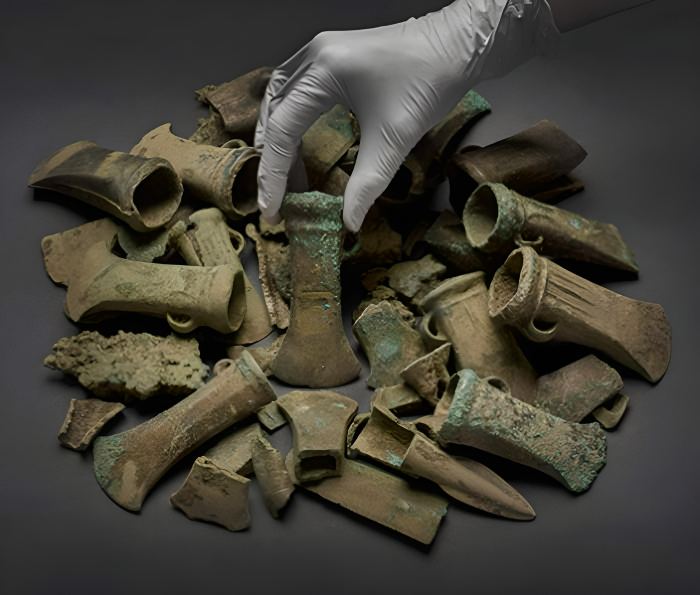
These archeological discoveries provide a rather straightforward picture of life: people lived in tiny farms or communities, and their homes were typically built of wood with stone foundations. There were no large cities or even historically significant structures in this area. There were often just local leaders, and the social structure was not very hierarchical.
However, our predecessors had already made great advancements in the mining and metalworking arts. They mined copper and other ores and produced ornately designed jewelry, swords, and cult artifacts. Trade links with the South and Scandinavia also existed at the time. The Amber Road linked the Baltic with the highly developed civilizations of the Mediterranean, and ore was carried, for instance, through the Alps and to the east.
What were their observations of the sky?
What about the understanding of astronomy, though? How well-versed in the celestial cosmos and the rules of the sun and moon were the Europeans of the Bronze Age? Theoretically, the trade commodities might have carried sophisticated astronomical knowledge from the Near East to Central Europe. On the other hand, it is known that European Stone Age tribes already had an understanding of astronomy and utilized it as a timer for ceremonial and agricultural activities, which brings to mind Stonehenge and Goseck.
However, a few new archeological discoveries suggest that this knowledge was not only retained throughout the Bronze Age but also advanced.
The Nebra Sky Disk

A Bronze Age discovery, graves, and robbers
It is the most well-known astronomical artifact from the European Bronze Age and a UNESCO document. However, it nearly completely vanished into unreachable channels. The story of the Nebra Sky Disk’s discovery is a truly suspenseful tale. Illegal excavations, shady art dealers, robbers, and an archaeologist are the main actors in the story.
In Germany’s woodland, in the summer of 1999, a crime thriller was set. Under the crest of the Mittelberg near Nebra, two guys were skulking about the Ziegelroda Woodland using metal detectors to search the forest floor. They are searching for artifacts, particularly guns or jewels that can be sold for cash. Their odds were strong since this region was already home to some 800 Bronze Age burial mounds.

The gadget beeps loudly out of the blue—it’s a find. As soon as the two thieves began digging on the woodland floor, they found a circular, dark-gray disk that was roughly 30 centimeters in diameter. But first, they showed little interest in it. The two gold-plated swords, several bracelets, and hatchets they discovered were much more fascinating. The disk was somewhat damaged during the excavation, so the two thieves collected the findings and the broken disk before attempting to transform their plunder into cash.

Undercover archaeologist
They got $15,000 for their discovery from a dealer; although this sum may seem like a lot of money to the two novice thieves, it was really much too little when compared to the true worth of the findings. The numerous dubious traders who received the findings were aware of this. They were all unaware of the significance of the obscure disk, however. One of them even made an attempt to use steel wool to clean the soiled portion. Then, one of the merchants offered the pieces to several museums, which made the authorities wonder.
They devised a covert operation in an effort to recover the items and bring the criminals to justice. In order to set up a covert meeting with the thieves in a Basel hotel in February 2002, the Saxony-Anhalt State Office for Archaeology pretended to be a potential buyer, and just at the right moment, Swiss police stepped in and arrested the burglars, a teacher, and a museum educator. In 2003, the two thieves revealed the precise location of the disk as well as the discoveries that went along with it.
At least 3,700 years old

Even the first studies of the mysterious disk indicated something remarkable: the seemingly innocuous discovery was made of bronze, and it was decorated with celestial symbols made of sheet gold, including a crescent moon, a full moon, stars with pointed ends, and golden arcs. Using the so-called exchange procedure, the gold was fastened to the bronze plate. The gold plate’s edge was forced into the groove that had been cut into the bronze and secured therein for this purpose. Europe had been familiar with this kind of metallurgy since the Bronze Age.
But how ancient was this artwork—could it date to the Bronze Age, for example? Since the disc itself doesn’t contain any carbon that might have been dated using the radiocarbon technique, it was challenging to date it. However, the objects found with them provided a hint: Archaeologists determined that the swords and bracelets were buried by their owners in the Bronze Age, or approximately 1600 BC, based on the design of the items.
The Nebra Sky Disk is a remarkable artifact in archaeology and is now thought to be between 3,700 and 4,100 years old. This disk is among the ten most significant archaeology-related artifacts ever because of its antiquity, craftsmanship, and theme.
But what exactly did the Sky Disk signify, and what was its function?
Moon and the Pleiades

The Sky Disk as a sign of the arrival of spring
Sun, moon, and stars are what the sky disk of Nebra symbolizes, and it is obvious that it must be related to the sky because of this. As a result, the disk is the only artifact from the Bronze Age or earlier to have such distinct and obvious astronomical connections. It is regarded as the earliest sky image made of concrete in existence. The earliest Egyptian concrete celestial depictions are from a period around 200 years later.
Of course, earlier representations of the night sky exist, such as those found in the Old Kingdom of Egypt. However, they just depict stars in a schematic grid pattern and are essentially decorative. The Nebra Sky Disk, however, seems to be an incredibly accurate representation of a very specific astronomical circumstance. But for what reason did this disk, which was already valued at the time, exist?
A first cue is provided by the noticeable cluster of dots located above the crescent moon and the gold disk: Most archaeoastronomers believe that the Pleiades, or the seven stars, is represented by these seven dots. Even with the naked eye, you can see this open star cluster in the Taurus constellation. As a result, it has been used to identify certain points throughout the year since ancient times.
The Pleiades were visible in the sky from spring through October around 3600 years ago, during the period of the Nebra Sky Disk. Each year around March 10 at nightfall, they rise for the first time, and in October at dawn, they set for the final time. For many societies of the Bronze Age, their rising signaled the arrival of spring and the time to start planting. On the other hand, the sinking was seen as a sign of the end of the harvest season. The Pleiades are calendar stars of the first tier.
Astronomical mnemonic
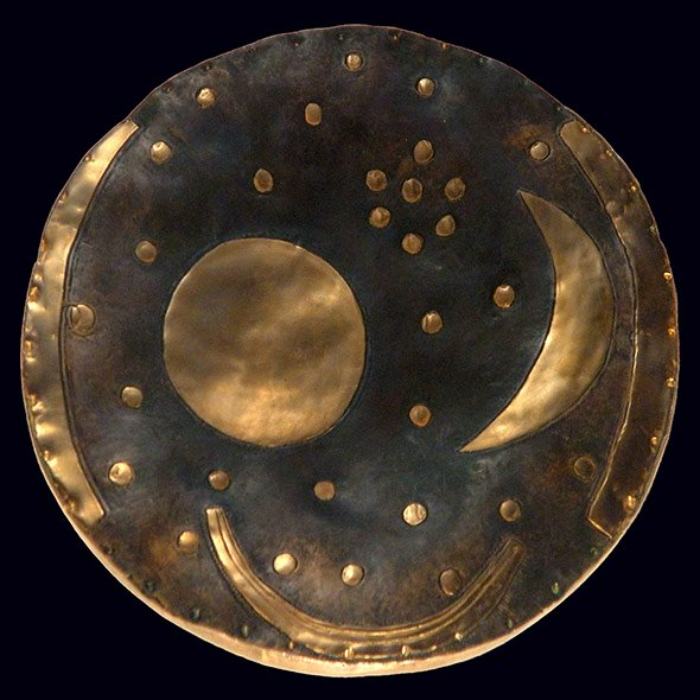
It follows that this collection of points was likewise employed by the designers of the sky disk to symbolize the Pleiades. There is no chance that the Pleiades are on the disk adjacent to the crescent moon and on the spherical disk near the full moon or the sun. The moon would have formed a crescent if the Pleiades were in conjunction with it as it rose in the spring, after recently passing a new moon. On the other hand, the moon was always full when the Pleiades and the moon were in conjunction in the fall.
The Nebra Sky Disk could have been used by Bronze Age people as a calendrical mnemonic, or an astronomical symbol signifying the start of spring. It would seem sensible that the remaining 25 gold dots on the disk would likewise represent actual constellations, but oddly enough, this is not the case. Instead, it seems like the dots are placed carefully to minimize pattern formation.
The “distance preservation” of the things on the bronze disk is virtually abnormal. It’s possible that these dots are stars, but their purpose is only to indicate that the sky is involved. The Pleiades are the only concrete stars that are intended. The Bronze Age disk, however, tells much more about the sky than just the start of spring and the Pleiades.
Observing the solstices and equinoxes
What do the arcs of the horizon on the sky disk mean?
The sun and moon were the most significant indications for our ancestors, even in the Stone Age. The ceremonial and agricultural years were distinguished by the summer and winter solstices, the moon phases, the rising and setting of the sun, and the months. Among other things, the solar observatory at Goseck, which was constructed around 7,000 years ago, demonstrates that people living in Central Europe were already keeping track of the sun and moon’s movements at that time.
82° angle, with golden arcs
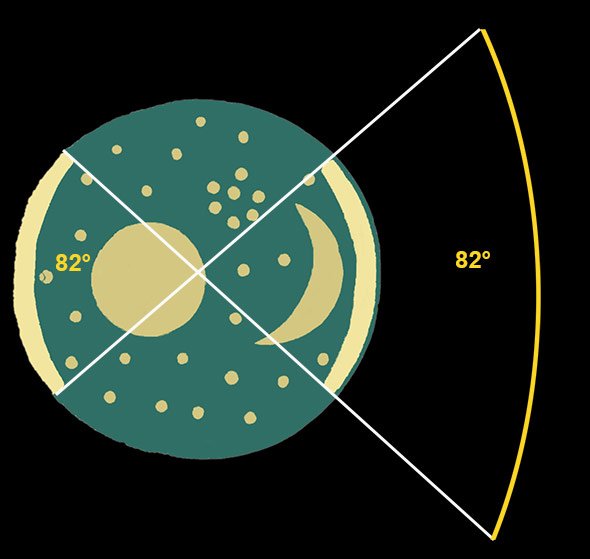
But what function did the Nebra Sky Disk serve here? The disk’s two eye-catching golden rim arcs are used in this situation. The metal analysis demonstrates that they were added after the majority of the other gold jewelry. Thus, they are a part of the disk’s second phase of usage. It’s fascinating how long they are since they span an 82° arc. This appears odd for a simple decoration since, for symmetry’s sake, one would anticipate a 90° circular quarter.
But if you search for angles of 82 degrees in astronomy, you will discover what you need: The sunsets move through precisely 82° from one solstice to the next in the latitude where Saxony-Anhalt is situated. The sunrises follow the same rules. The position of the Nebra Sky Disk’s discovery makes it possible to use it as a useful tool to pinpoint key solar year-corner events like solstices and equinoxes.
Sun over the Brocken
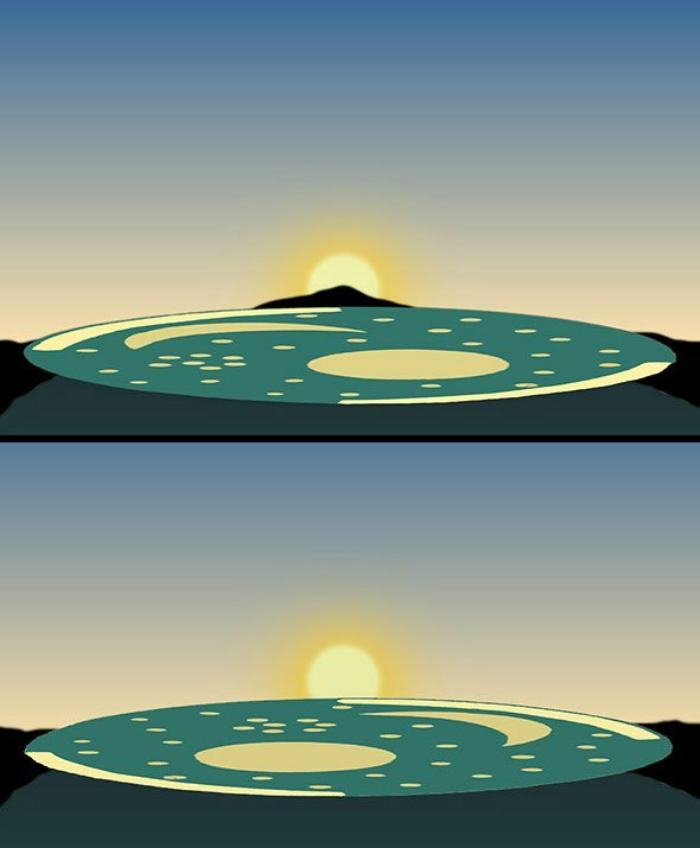
This is due to the fact that the sun sets almost precisely over the peak of the Brocken, which is located around 85 kilometers distant, as viewed from the location where the disk was discovered below the Mittelberg at the summer solstice. On this day, the sky disk is adjusted such that one end of the horizon arc close to the crescent moon precisely points to sunset and the Brocken.
The golden arc, which you can see if you keep the Nebra Sky Disk in this position over the next few days and weeks, indicates the migration of the sunsets. The winter solstice occurs when the setting sun in winter reaches the furthest point of its arc; from this point on, sunsets begin to migrate in the other direction. A fresh cycle starts as the days become longer. It is still unclear, nevertheless, if the owners of the Nebra Sky Disk during the Bronze Age really used it for this usage. However, it is at least likely given that the two horizon arcs were constructed later.
But further studies turned out to reveal an even more intricate use for the Nebra Sky Disk.
Using the Nebra Sky Disk as a leap-year indication
The thick crescent moon
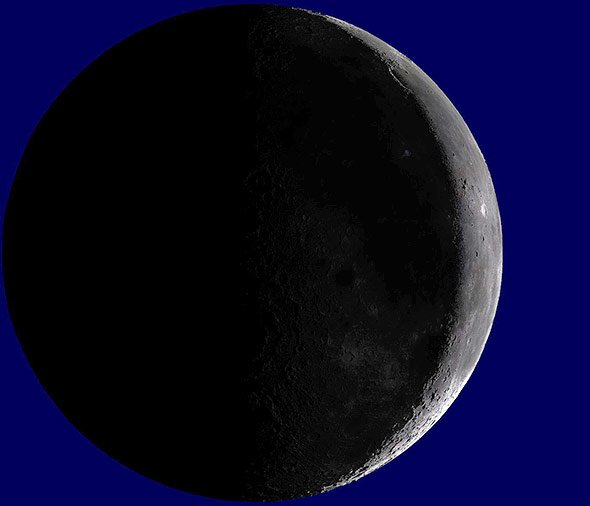
At first sight, the crescent moon on the Nebra Sky Disk seems pretty typical, with bent ends. However, it doesn’t exactly match the picture from an astronomical standpoint. because it is too thick to clearly see the moon’s small crescent immediately after a new moon. But once again, it is too thin to depict the crescent moon. Instead, it portrays a moon that is in an intermediate state and is around four days old.
For proof of a four-day crescent moon, researchers looked through the annals of other early Bronze Age nations. They discovered what they sought in the Babylonians: The thickness of the moon at the start of spring was a crucial indicator of whether or not a leap month was due in the Mul-Apin, an astronomical cuneiform document from the 7th century B.C.
It is balanced by a leap month
The Babylonians used a hybrid of solar and lunar calendars, much like many other highly developed Bronze Age civilizations. The moon’s phases were used to establish the months, which ranged from new moon to new moon. The issue with this is that a year made up of twelve lunar months is eleven days shorter than a year made up of 360 solar days. As a result, over time, the lunar year changes in opposition to the seasons, which is highly unfeasible.
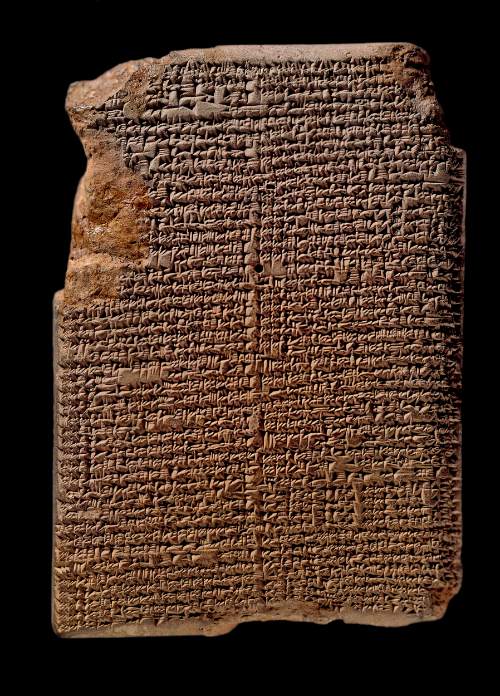
The Babylonians came up with a solution by turning on an extra leap month every two to three years. At the start of spring, they took the moon as a sign that it was time: If there was just a very thin crescent moon close to the Pleiades, everything was still in balance, thus a leap month wasn’t required. The lunar year had to be shifted if the moon was already a few days old when it made its conjunction with the Pleiades.
Thick moon next to the Pleiades
Exactly what is seen on the Nebra sky disk is this constellation, which includes the Pleiades and a four-day crescent moon. The owners simply needed to compare the moon’s appearance to that of its golden representation on the disk when the Pleiades are rising in the spring. If it was thinner, everything was OK; if it seemed to be the same thickness, a leap month was required.
This caused a scandal among archaeologists and archaeoastronomers: could the purportedly technologically illiterate Bronze Age inhabitants of Nebra have previously been able to follow such a complicated lunisolar calendar? We wouldn’t have thought they were capable of it. The reason for this is that without writing, even long-term astronomical change tracking was difficult.
Import from Mesopotamia

Therefore, it is questionable if the designers of the Sky Disk really independently came up with this knowledge. The Bronze Age trade lines from the Near East to Eastern Europe and from there to Nebraska appear to have been the most probable source of knowledge about the leap month. We find the idea that this norm originated in a society devoid of writing to be less plausible than the idea that a link to Mesopotamia conveyed this knowledge.
The sky disk may have been created as a memory and identification aid by a shaman, druid, or other scholar who had learned about the lunisolar calendar and leap year of the Babylonians via interactions with merchants. The workings of the disk were probably only known to a very restricted group of individuals. And when they passed away without passing on their wisdom, the sky disk’s function was likewise rendered useless.
By the time the sky disk was buried, it had long ago ceased to be used as a calendar measuring device and was only being used for ceremonial reasons, as shown by the improvements to the horizon arcs, solar barque, and mounting holes. It eventually turned into a cult item.
Was the Trundholm Sun Chariot a calendar?
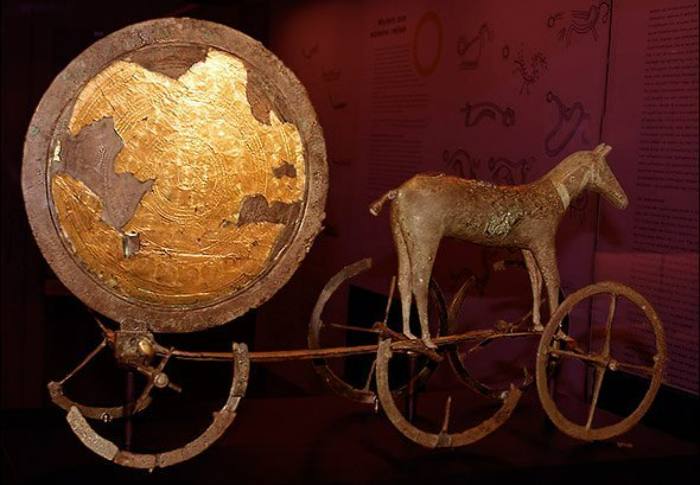
However, there may be more proof that Bronze Age inhabitants of Central Europe were already familiar with and used a combined solar and lunar calendar in addition to the Nebra Sky Disk. The Trundholm Sun Chariot, a piece of Bronze Age art that was uncovered in Denmark in 1902, may possibly serve as proof.
The path of the sun
The Trundholm Sun Chariot, which dates back to circa 1400 BC, is composed of an upright disk with gold decoration on one side that is supported by a form of the cart and drawn by an image of a horse. The disk, which is around 25 cm in diameter, has rings of spirals and circles that are concentrically organized on both sides.
Since comparable sun chariots are shown in numerous ancient societies, it is apparent that this sun chariot was primarily used for religious and cultic purposes. They represent the path the sun takes over the midday sky. This is further confirmed by the way in which the horse and chariot are oriented: when seen from the side of the Trundholm Sun Chariot that faces the golden day, the horse goes to the right, mirroring the sun’s motion from east to west in the sky.
A calendar for astronomical counting
But the Trundholm Solar Chariot’s designers could have had an even more profound and useful intention. The arrangement of the decorations on the solar disk holds the solution to this problem. There is disagreement among experts as to how precisely these spirals and circles may have been used as a form of counting calendar by Bronze Age inhabitants.
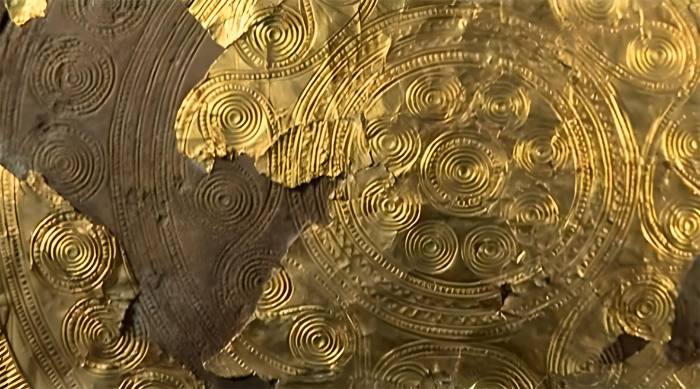
The spirals on the night side may be used to tally the days of the lunar year, according to Klaus Randsborg of the University of Copenhagen. He estimates that 177 is obtained by multiplying the total number of spirals in each ring of the disk by the number of the ring in which they are located. 177 days are equivalent to six lunar months, or half a lunar year.
Spirals as days and weeks
According to some scholars, the pattern on the night side has a reference to the solar year: Eight symbols that represent days and may signify a week are located on the disk’s inside. Ancient Etruscans and, for a brief while, even the Romans used calendars with eight-day weeks.
The 45 spirals in the two outer rings, according to Sparavigna, represent the seven days of the week. The result is 360 days, or about one solar year, if one doubles both quantities at this point. The five missing days, or a kind of changeover time, may therefore be represented by the circle’s center.
Maybe a lunar eclipse calendar as well

Some academics even believe that the Trundholm Sun Chariot’s motifs represent a lunar eclipse calendar. The pattern of lunar eclipses repeats every 18 years and 10 days, as was early understood by experts in Mesopotamia and ancient China. Therefore, the Saros cycle may be used to forecast when the next eclipse will occur. It is unknown, nevertheless, if similar views were shared by the Central and Northern Europeans of the Bronze Age in their scriptless civilization.
The Trundholm Sun Chariot’s actual purpose and whether it actually acted as a calendar are therefore still unknown. It is difficult to evaluate the level of knowledge of the Bronze Age inhabitants of this area in the absence of written records. Again, the symbols on the disk may have been nothing more than a lovely ornament. The only thing that is really certain is that the filigree components demonstrate a high degree of metalworking and casting expertise, proving that Bronze Age artists were already highly developed, even in northern Europe.
The Gold Hats as calendars
Sunbeams, circles, and diamonds
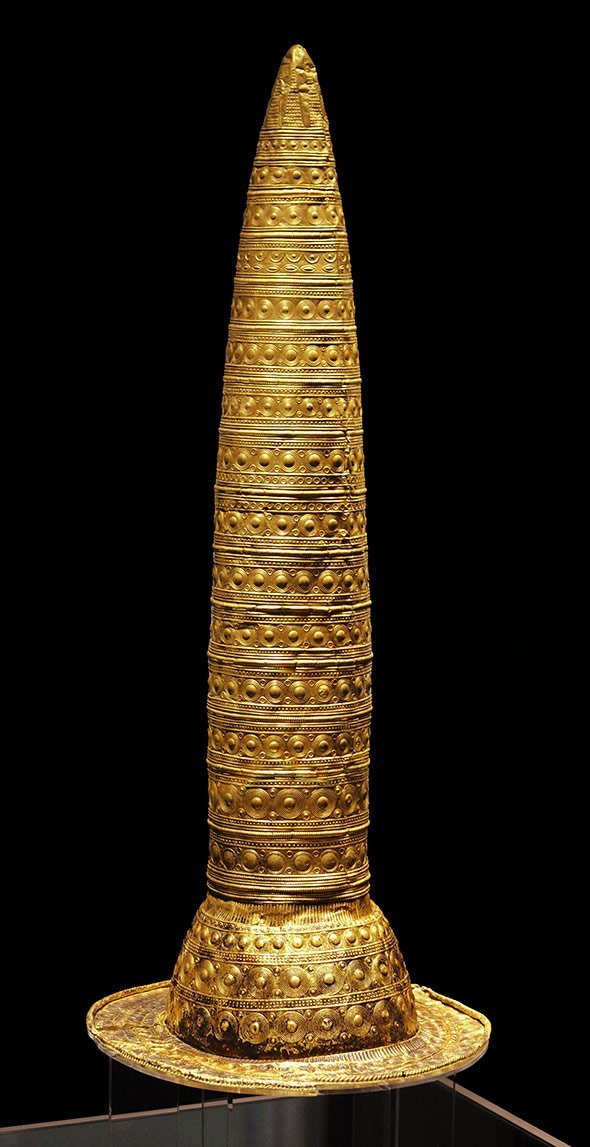
They are also a part of the late Bronze Age gold hats, which are intriguing and are still being studied. Four of these cone-shaped pieces of Urnfield Culture art, hammered from thin gold sheet, have so far been discovered in Europe; three are in Germany and one is in the west of France.
Cult jewelry for the affluent
Priests most likely wore these conical hats on cultic occasions because they were still about 75 centimeters tall. Therefore, it is most likely not an accident that the lower aperture fits almost precisely on a man’s skull. The complete hat weighs less than 500 grams since the gold plate was pushed out so thin. However, the ornamentation of ribbons with circles and tiny jewels hammered into the gold sheet is what makes these gold hats distinctive.
Nothing in this sculpture, including the overall number of ornamental zones, the number of individual components, or even the number of rings around the many humps, is left to chance. Because several experts have discovered a sophisticated calendar that, like the sky disk, serves to connect the lunar year and the solar year in a series of rings and patterns.
Saros cycle, solar year, and lunar year
The 354 days of a lunar year are produced, for instance, by adding the decorations from Berlin Gold Hat zones 2 to 18. However, specific switching zones also make it possible to count the sun months on the patterns. Even the Saros cycle, which heralds the recurrence of lunar eclipses, could have been inscribed on the hat made of gold. because 223 is the length of a Saros cycle in months when all the ornaments from zones 3 to 13 are added together.
On the Berlin Gold Hat, the fifth zone from the top has a unique design that combines 19 lying crescent moons with lying lozenges. They could last for the 19 years of the lunar cycle, after which the solar and lunar cycles will once more coincide. Meton, a Greek scholar, calculated and recorded this cycle, so it now bears his name (Metonic Cycle).
Numerous assumptions, little knowledge
However, as with the Trundholm Sun Chariot, these are currently little more than hypothetical number games. Because there are some hints that a system and possibly a calendar exist, as well as the pattern of the gold hats. What the various circles and patterns actually mean, however, and how intricate this was, remain a mystery.
The sun chariot, the sky disk, and the gold hats are only a few pieces of an enormous jigsaw puzzle which are the European Bronze Age societies. Therefore, it is not easy to claim that these civilizations have “deep astronomical knowledge.” Because it remains conjecture without an understanding of the archaeological, religious-historical, and anthropological background. But it is exactly this background knowledge about the individuals who developed the Nebra Sky Disk and other astronomical artifacts of this period that we lack at this time.
Bibliography
- The Nebra Sky Disc dates from the Early Bronze Age – The Austrian Academy of Sciences
- Nebra Sky Disc | UNESCO
- Ehser, Anja; Borg, Gregor; Pernicka, Ernst (2011). “Provenance of the gold of the Early Bronze Age Nebra Sky Disk, central Germany: geochemical characterization of natural gold from Cornwall”. European Journal of Mineralogy. 23 (6): 895–910. Bibcode:2011EJMin..23..895E.
- The Nebra Sky Disc – Archaeology Magazine


